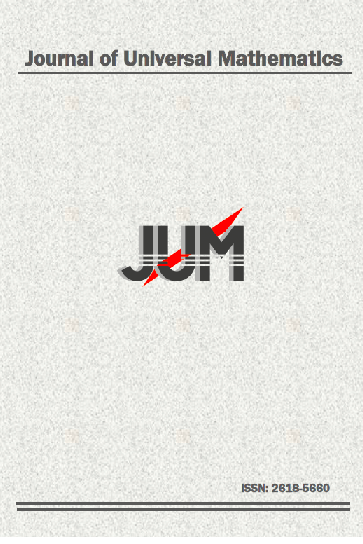DNA CODES FROM REVERSIBLE GROUP CODES BY A VIRUS OPTIMISATION ALGORITHM
DNA CODES FROM REVERSIBLE GROUP CODES BY A VIRUS OPTIMISATION ALGORITHM
DNA codes, reversible codes, group codes,
___
- L. Adleman, Molecular computation of the solutions to combinatorial problems, Science, Vol. 266, pp. 1021{1024 (1994).
- K.G. Benerjee, S. Deb, M.K. Gupta, On conict free DNA codes, Cryptogr. Commun. Vol.13,pp.143{171 (2021). https://doi.org/10.1007/s12095-020-00459-7. DNA CODES 43
- W. Bosma, J. Cannon, C. Playoust, The Magma algebra system. I. The user language, J. Symbolic Comput., Vol. 24, pp. 235-265 (1997).
- Y. Cengellenmis, A. Dertli, S.T. Dougherty, A. Korban, S. Sahinkaya, D. Ustun, Reversible G-Codes over the Ring Fj;k with Applications to DNA Codes, Advances in MAtehematics of Communication, (2023) Doi: 10.3934/amc.2021056.
- Cuevas, J. R., H. J. Wang, Y. C. Lai, Y. C. Liang, Virus Optimization Algorithm: A Novel Metaheuristic for Solving Continuous Optimization Problems, The 10th Asia Paci_c Industrial Engineering Management System Conference, pp.2166{2174 (2009).
- S.T. Dougherty, J. Gildea, R. Taylor, A. Tylshchak, Group rings, G-codes and constructions of self-dual and formally self-dual codes, Designs, Codes and Cryptography, Vol. 86, pp.2115-2138 (2018).
- P. Gaborit, O. D. King, Linear Constructions for DNA Codes, Theoretical Computer Science, Vol.334, pp.99-113 (2005).
- F. Gursoy, E. S. Oztas, I. Siap, Reversible DNA codes over F16 + uF16 + vF16 + uvF16, Adv. Math. Commun., Vol.11, pp.307-312 (2017).
- H. J. Kim, W-H. Choi, Y. Lee, Designing DNA codes from reversible self-dual codes over GF(4), Discrete Mathematics, Vol.344, (2021).
- A. Korban, S. Sahinkaya, D. Ustun, An Application of the Virus Optimization Algorithm to the Problem of Finding Extremal Binary Self-Dual Codes, Advances in Matehematics of Communication, (2022) Doi: 10.3934/amc.2022098.
- A. Korban, S.Sahinkaya, D. Ustun, DNA Codes from Reversible Group Codes by a Virus Optimisation Algorithm, Available at https://sites.google.com/view/adriankorban/generator-matrices.
- A. Marathe, A.E. Condon, R.M. Corn, On combinatorial DNA word design, J. Comput. Biol., Vol.8, pp.201-220 (2001).
- J.L. Massey, Reversible codes, Information and Control, Vol.7, pp.369-380 (1964).
- W. Song, K. Cai, M. Zhang, C. Yuen, Codes with run-length and GC-content constraints for DNA-based data storage, IEEE Commun. Lett. Vol.22, No.10, pp.2004{2007 (2018). https://doi.org/10.1109/LCOMM.2018.2866566.
- E. S. Oztas, B. Yildiz, I. Siap, A novel approach for constructing reversible codes and appli- cations to DNA codes over the ring F2[u]=(u2k1), Finite Fields and Their Applications, Vol.46, pp. 217-234 (2017).
- E.S. Oztas, I. Siap, Lifted Polynomials over F16 and Their Applications to DNA Codes, Filomat, Vol.27, pp.459-466, (2013).
- X. Zhu, C. Sun, W. Liu, W. Wu, Research on the counting problem based on linear constructions for DNA coding, In: Proceedings Computational Intelligence and Bioinformatics, pp. 294{302 (2006).
- ISSN: 2618-5660
- Başlangıç: 2018
- Yayıncı: Gökhan ÇUVALCIOĞLU
ON LEAP ZAGREB INDICES OF A SPECIAL GRAPH OBTAINED BY SEMIGROUPS
EXACT SOLUTION OF THE SCHRODINGER EQUATION IN TOPOLOGICALLY MASSIVE SPACETIME
ABOUT GROUP OF POINTWISE INNER AUTOMORPHISMS FOR NILPOTENCY CLASS FOUR
Rukayat BANİRE, Olanrewaju O FABELURİN, Professor DR., Adeleke Timothy ADEMOLA, Omeike MATHEW
DNA CODES FROM REVERSIBLE GROUP CODES BY A VIRUS OPTIMISATION ALGORITHM
